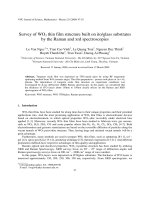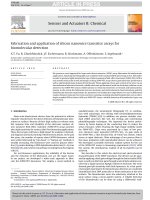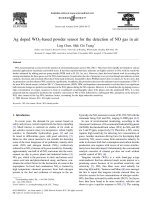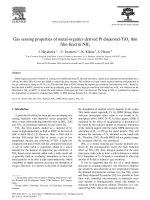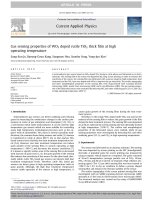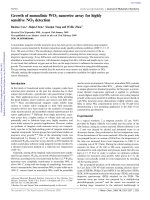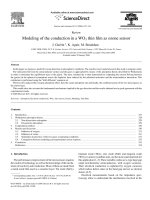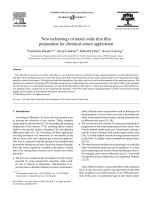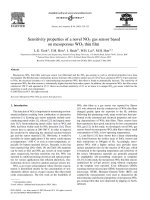- Trang chủ >>
- Khoa Học Tự Nhiên >>
- Vật lý
wet process-based fabrication of wo3 thin film for no2 detection
Bạn đang xem bản rút gọn của tài liệu. Xem và tải ngay bản đầy đủ của tài liệu tại đây (222.52 KB, 5 trang )
Sensors and Actuators B 101 (2004) 107–111
Wet process-based fabrication of WO
3
thin film for NO
2
detection
Yong-Gyu Choi, Go Sakai, Kengo Shimanoe, Noboru Yamazoe
∗
Department of Materials Science, Faculty of Engineering Sciences, Kyushu University, Kasuga-shi, Fukuoka 816-8580, Japan
Received 12 November 2003; received in revised form 6 February 2004; accepted 7 February 2004
Available online 8 April 2004
Abstract
It was tried to fabricate a WO
3
thin film device through a wet process starting from an aqueous sol of WO
3
·2H
2
O. When mixed with
polyethylene glycol (PEG, molecular weight 6000), the sol was made compatible to spin coating on an alumina substrate and the coating
could be converted into a WO
3
thin film by calcination at 300
◦
C for 2 h. Starting with a typical coating dispersion containing WO
3
·2H
2
O
by 5 mass% on WO
3
basis and 2 mass% PEG, the WO
3
film obtained was 450 nm in mean thickness. The film was a slim pack of square
plates, each of which was a stack of thin lamellar crystals of WO
3
. The device was sensitive enough to detect 50 ppb NO
2
in air at 200
or 250
◦
C, although the response and recovery transients were rather sluggish. Unexpectedly, the transients were found to be sharpened
drastically in humid atmosphere, while sensor response (sensitivity) to NO
2
was hardly degraded with humidity.
© 2004 Elsevier B.V. All rights reserved.
Keywords: Tungsten oxide; Gas sensor; NO
2
; Thin film; Sol
1. Introduction
For semiconductor gas sensors, WO
3
is an important base
oxide which exhibits high sensitivity to non-hydrocarbon
gases, like NO
2
and NH
3
[1–3]. So far various methods have
been adopted for preparing WO
3
as a sensor material, in-
cluding pyrolysis of (NH
4
)
10
W
12
O
41
·5H
2
O [1–3], sputter-
ing or evaporation from a source of WO
3
[4–9], and sol–gel
processes starting from W-alkoxide [10]. However, it is dif-
ficult to control the microstructure of WO
3
-based devices,
i.e. the shape, size and stacking of WO
3
particles included,
by these methods. Recently, we reported that an aqueous
colloidal dispersion (sol) of WO
3
·2H
2
O could be prepared
though wet processes starting from an ion-exchange reac-
tion of Na
2
WO
4
[11]. The sol could be converted into a gel
by centrifuge, making it possible to fabricate a thick film by
a screen-printing method. The resulting film of WO
3
was
found to exhibit fairly excellent NO
2
sensing properties
if the sol had been subjected to ultrasonic or centrifugal
treatments under proper conditions, which affected the mor-
phology of WO
3
crystals [12,13]. Apart from thick films,
it is also of interest to fabricate thin films of WO
3
from the
WO
3
·2H
2
O sol. Unfortunately, this has been postponed be-
cause it was difficult to obtain a uniform thin film from the
sol by a spin-coating method. However, it has been found
∗
Corresponding author. Tel.: +81-92-583-7537; fax: +81-92-583-7538.
E-mail address: (N. Yamazoe).
that, when mixed with an organic binder (polyethylene gly-
col, PEG), the sol gives a thin film on an alumina substrate.
This paper aims at reporting morphology and NO
2
sensing
properties of WO
3
thin films thus obtained.
2. Experimental
A colloidal dispersion (sol) of WO
3
·2H
2
O was prepared
in the same way as reported elsewhere [11]. An aqueous so-
lution of Na
2
WO
4
(0.15 M) was let to pass through a column
packed with protonated cation exchange resin (Diaion SK
1B). The effluent was kept standing for 3 days before it de-
posited a gel. The gel, collected by decantation, was washed
with deionized water, and recollected by centrifuge and de-
cantation. The washed gel was dispersed in deionized water
again to form a WO
3
·2H
2
O sol. The sol contained colloidal
particles of crystalline WO
3
·2H
2
O of about 30 nm in size.
The content of WO
3
·2H
2
O in the sol was set to be 5mass%
on the WO
3
basis unless otherwise noted. PEG with aver-
age molecular weight of 6000 was added to the above sol
by 2mass% unless otherwise noted to obtain a spin-coating
dispersion. The dispersion was spin coated on an alumina
substrate attached with a pair of interdigited gold electrodes
(300 m in separation between electrodes) under the rotation
speed of 1500rpm. The obtained thin film of WO
3
·2H
2
O
was calcined at 300
◦
C for 2 h for conversion of WO
3
·2H
2
O
to WO
3
as well as sintering. Gas sensing experiments were
carried out in a conventional flow apparatus equipped with a
0925-4005/$ – see front matter © 2004 Elsevier B.V. All rights reserved.
doi:10.1016/j.snb.2004.02.031
108 Y G. Choi et al. /Sensors and Actuators B 101 (2004) 107–111
heating facility at a gas flow rate of 100cm
3
/min. The con-
centration of NO
2
was varied between 10 and 1000 ppb by
diluting a parent NO
2
gas (1 ppm in dry air) with dry air.
When necessary, part of the air was humidified by babbling
through water phase.
3. Results and discussion
3.1. Morphology of WO
3
thin films
Thin films of WO
3
could be derived from the WO
3
·2H
2
O
sol added with PEG (2 wt.%) by one time spin coating and
calcination at 300
◦
C for 2 h. Fig. 1 shows SEM images of
the thin films obtained. The films were an irregular packing
of square plates of WO
3
, 0.5–1m in width and 0.2–0.5 m
in thickness. Each square plate was a stack of thin plates
(lamellae) of less than 100 nm in thickness. This morphology
was unchanged regardless of the WO
3
·2H
2
O contents in the
spin-coating dispersion, i.e. 1mass% Fig. 1a and 5 mass%
Fig. 1b. Actually the outlook of WO
3
crystals, featured by
lamellar structure, was essentially the same as what we ob-
served for the WO
3
thick films prepared by a screen-printing
method [12,13]. The lamellar structure has its origin in the
crystal habit of WO
3
·2H
2
O, which tends to grow into thin
Fig. 1. SEM images (top and cross-sectional views) of WO
3
thin films derived from WO
3
·2H
2
O sols (PEG 2mass%). WO
3
·2H
2
O content: (a) 1mass%,
(b) and (c) 5 mass%.
plates in the sol. During the drying process, the thin plates
are stacked together to form square plates having lamel-
lar structure. The lamellar structure is preserved even after
WO
3
·2H
2
O is dehydrated finally into WO
3
by calcination
(dehydration temperature about 200
◦
C). We have shown
that topotaxy holds well between the crystals of WO
3
·2H
2
O
and that of WO
3
: The basal plane (010) of WO
3
·2H
2
Ois
converted into the basal plane (002) of WO
3
[12].
As shown by the cross-sectional view Fig. 1c, the thin
films were a slim layer of discrete square plates of WO
3
ly-
ing on the substrate. In the direction normal to the substrate,
a few plates were stacked in some spots, while only a single
plate existed in other spots. With such a gross population,
the films were hardly uniform in thickness. Nevertheless, the
thickness of the layer was measured visually at arbitrarily
selected five spots to obtain their mean value for each film.
Fig. 2 shows the mean thickness thus obtained as a func-
tion of WO
3
·2H
2
O content (1–5 mass%) of the spin-coating
dispersion, together with the maximum and minimum in
thickness measured. Although the thickness fluctuated sig-
nificantly depending on spots within a single film, the mean
thickness tended to increase monotonically with increasing
WO
3
content. The film derived from 5mass% WO
3
·2H
2
O
dispersion, 450nm in the mean thickness, was supplied to
the subsequent gas sensing experiments.
Y G. Choi et al. /Sensors and Actuators B 101 (2004) 107–111 109
Fig. 2. Mean thickness of WO
3
thin films derived from WO
3
·2H
2
O sols
as a function of WO
3
·2H
2
O content (mass% on the WO
3
basis). Vertical
bars show maxima and minima in thickness.
Remarks are given here to the role and fate of PEG added
to the spin-coating dispersion. As stated earlier, it was unable
to deposit a layer of WO
3
·2H
2
O crystals on the substrate
from a neat WO
3
·2H
2
O dispersion by spin coating. Obvi-
ously, the deposition of WO
3
·2H
2
O crystals in the present
case was assisted greatly by PEG. It is known that PEG in-
creases the viscosity of the dispersion. In fact, the viscosity
of the spin-coating dispersions containing 0 and 2 mass%
PEG was 1.0 and 1.4cP, respectively. An increase in viscos-
ity would make the dispersion more adhesive to the substrate,
giving the WO
3
·2H
2
O crystals more chances to deposit in
the spin-coating process. It is thus considered at present that
the primary role of PEG is to increase the viscosity of the dis-
persion. Part of PEG would be left behind in the spin-coated
film. As revealed by thermogravimetric analysis, however,
PEG molecules began to decompose at about 200
◦
C, and
no residues remained after calcination at 300
◦
C for 2 h.
Fig. 3. Response and recovery transients of electrical resistance to switching-on and -off 100 and 500 ppb NO
2
in dry air at three selected temperatures.
(Film derived from a dispersion of 5 mass% WO
3
·2H
2
O and 2 mass% PEG.)
3.2. NO
2
sensing properties in dry atmosphere
The WO
3
thin film derived from the dispersion of
5 mass% WO
3
·2H
2
O was examined for NO
2
sensing prop-
erties at 200, 250 and 300
◦
C. Response and recovery
transients in electrical resistance to switching-on and -off
100 and 500 ppb NO
2
are shown in Fig. 3. Response and
recovery were both rather sluggish, taking about 10 min
or more for 90% of full response or of full recovery at
all temperatures. This was in contrast to the case of thick
films (about 6 m in thickness) reported previously [12,13],
where the 90% response or recovery times were less than
2 min for the films calcined at 300
◦
C. The electrical re-
sistance of the thin film device in air (R
a
) was fairly high,
exceeding 10
7
at 200
◦
C. Accordingly, the resistance
under exposure to NO
2
in air (R
g
) easily went beyond
the limit of reliable measurement range (∼10
9
)even
for small concentrations (e.g. 500ppb) of NO
2
. The upper
limiting concentration of NO
2
practically acceptable was
rather low, for example, being smaller than a few hundred
ppb at 200
◦
C. Within this limitation, the present film was
quite sensitive to NO
2
. As seen from Fig. 4, where sensor
response as expressed by normalized resistance (R
g
/R
a
)is
shown as a function of NO
2
concentration at three different
temperatures. At 200
◦
C, sensor response was as large as
7–50 ppb NO
2
. With a rise in temperature, sensor response
reduced rather sharply, showing 50 and 10–500 ppb NO
2
at
250 and 300
◦
C, respectively. Nevertheless, sensor response
to 50 ppb NO
2
at 250
◦
C was still 3, assuring that the device
was sensitive enough even at this temperature to meet the
detection of environmental NO
2
(environmental standard:
40–60 ppb in Japan). For comparison, sensor response of the
screen-printed thick film device was also shown in the same
figure. It is seen that the present device is more sensitive
to NO
2
than the thick film device at 200
◦
C, although such
110 Y G. Choi et al. /Sensors and Actuators B 101 (2004) 107–111
Fig. 4. Normalized resistance (R
g
/R
a
) as a function of NO
2
concentration
for a thin film device (full lines and filled marks) and a thick film
device (broken lines and open marks) at three selected temperatures (dry
atmosphere).
superiority is reduced and almost lost at 250 and 300
◦
C,
respectively.
3.3. Preparation under different conditions
The thin film device prepared above was found to have a
problem that the response and recovery transients were too
sluggish. Thus, thin film devices were prepared under dif-
ferent conditions. First, the content of PEG in the dispersion
was increased from 2mass% to 7, 15 or 20 mass%, while
keeping the WO
3
·2H
2
O content the same (5mass%). The
viscosity of the spin-coating dispersion was increased from
1.4 to 3.3, 8.0 or 11.3 cP, correspondingly, so that the film
thickness would be expected to increase in this order. Fig. 5a
shows the response and recovery transients to 50 ppb NO
2
for the resulting thin film devices, calcined at 300
◦
C. The
rate of response tended to be quicker with 15 and 20 mass%
PEG (transient (3) and (4)) than with 2 and 7 mass% PEG
((1) and (2)), whereas the rate of recovery was almost un-
changed regardless of the PEG content. As also seen from
the figure, the magnitudes of sensor response were about
the same, being large enough to safely detect 50ppb NO
2
for all the devices. These results indicate the necessity of
investigating the influences of high PEG content on the re-
sulting thin films in more detail in the future. Second, the
calcination temperature was raised from 300 to 400
◦
C. Re-
sulting transients are shown in Fig. 5b. The rates of both
response and recovery were made more sluggish as com-
pared with the case of Fig. 5a. The deterioration of response
and recovery rates with increasing calcination temperature
has been observed for the thick film devices, and the phe-
nomenon has been interpreted as reflecting an increase of
micro-pores in the WO
3
lamellae included [13]. In the case
of the thick films, however, fairly quick transients, taking less
than 2 min for 90% response or recovery, have been obtained
even after calcination at 400
◦
C. The sluggish transients of
the present thin films, shown in Fig. 5a and b, suggest that
the micropore structure may differ significantly from that
Fig. 5. Response and recovery transients to 50 ppb NO
2
in dry air for
WO
3
thin film devices, derived from WO
3
·2H
2
O sols different in PEG
content and calcined at 300
◦
C (a) and 400
◦
C (b). PEG content in mass%:
(1) 2, (2) 7, (3) 15 and (4) 20.
of the thick films, although this is also to be confirmed
experimentally.
3.4. Response to NO
2
in humid atmosphere
Finally, NO
2
sensing properties in humid atmosphere
were tested briefly by using a fresh thin film device, which
was derived from the dispersion added with 2 mass% PEG
and calcined at 300
◦
C. Fig. 6 shows response and recovery
transients to 1000 and 500 ppb NO
2
in air of 10% relative hu-
midity (RH) at 250 and 300
◦
C. Unexpectedly, the response
and recovery transients were found to be improved drasti-
cally under the humid atmosphere. The 90% response (re-
covery) times were about 1min (about 0.5min) at both tem-
peratures. It is remarkable that the recovery is quicker than
the response, because the reverse is the case usually. Almost
the same conclusion was drawn when relative humidity was
increased to 40 and 70% (data not shown here). The mech-
anism by which the humidity improves the transients is not
known well at present. It may be possible that the adsorption
of NO
2
in the micro-pores of WO
3
lamellae, which is consid-
ered to be responsible for the sluggish transients, is prevented
Y G. Choi et al. /Sensors and Actuators B 101 (2004) 107–111 111
Fig. 6. Response and recovery transients to 1000 and 500ppb NO
2
in
humid air (10% relative humidity) at 250 and 300
◦
C. (Device derived
from a dispersion of 5 mass% WO
3
·2H
2
O and 2 mass% PEG and calcined
at 300
◦
C.)
from occurring due to preferential condensation of water va-
por. Any way, it turned out that the problem of the present de-
vice, i.e. being sluggish in response and recovery, could thus
be eliminated in humid atmospheres. In addition, although
the resistance of the device in air (R
a
) was lowered by some
extent in the humid conditions, sensor response (R
g
/R
a
)
hardly degraded with humidity, as seen from the comparison
between Figs. 3 and 6. This suggests that the NO
2
sensing
may be carried out more favorably in humid atmospheres
than in dry atmosphere provided that the humidity level is
known separately. More detailed investigations are desired
for the NO
2
sensing properties in humid atmospheres.
4. Conclusions
An aqueous sol of WO
3
·2H
2
O, added with PEG, could
be applied successfully for fabricating a thin film of WO
3
on an alumina substrate by spin coating and calcination.
The thin film device obtained was sensitive enough to detect
dilute NO
2
in environments, though the response and recov-
ery transients were rather sluggish. Remarkably, the tran-
sients were made very sharp in humid atmospheres, while
sensor response (sensitivity) to NO
2
hardly degraded with
humidity.
Acknowledgements
This study was partially supported by a grant-in-aid for
Scientific Research from The Ministry of Education, Cul-
ture, Sport, Science and Technology of Japan.
References
[1] M. Akiyama, J. Tamaki, N. Miura, N. Yamazoe, Tungsten
oxide-based semiconductor sensor highly sensitive to NO and NO
2
,
Chem. Lett. (1991) 1611.
[2] T. Maekawa, J. Tamaki, N. Miura, N. Yamazoe, Gold-loaded tungsten
oxide sensor for detection of ammonia in air, Chem. Lett. (1992)
639.
[3] M. Ando, S. Suto, T. Suzuki, T. Tsuchida, C. Nakayama, N. Miura, N.
Yamazoe, H
2
S and CH
3
SH sensor using a thick film of gold-loaded
tungsten oxide, Chem. Lett. (1994) 335.
[4] G. Sberveglieri, L. Depero, S. Groppelli, P. Nelli, WO
3
sputtered
thin film for NO
x
monitoring, Sens. Actuators B 26/27 (1995) 89.
[5] P. Nelli, L.E. Depero, M. Ferroni, S. Groppelli, V. Guidi, F. Ron-
coni, L. Sangaletti, G. Sberveglieri, Sub-ppm NO
2
sensors based on
nanosized thin films of titanium–tungsten oxides, Sens. Actuators B
31 (1996) 89.
[6] D.J. Smith, J.F. Vetelino, R.S. Falconer, E.L. Wittman, Stability, sen-
sitivity and selectivity of tungsten trioxide films for sensing appli-
cations, Sens. Actuators B 13/14 (1993) 264.
[7] M. Penza, M.A. Tagliente, L. Mirenghi, C. Gerardi, C. Martucci, G.
Cassano, Tungsten trioxide (WO
3
) sputtered thin films for a NO
x
gas sensor, Sens. Actuators B 50 (1995) 9.
[8] B.T. Marquis, J.F. Vetelino, A semiconducting metal oxide sensor
array for the detection of NO
x
and NH
3
, Sens. Actuators B 77 (2001)
100.
[9] J.L. Solis, S. Saukko, L. Kish, C.G. Granqvist, V. Lantto, Semi-
conductor gas sensors based on nanostructured tungsten oxide, Thin
Solid Films 391 (2001) 255.
[10] K. Galatsis, Y.X. Li, W. Wlodarski, E. Comini, G. Sberveglieri, C.
Cantalini, S. Santucci, M. Passacantando, Comparison of single and
binary oxide MoO
3
, Sens. Actuators B 83 (2002) 276.
[11] Y G. Choi, G. Sakai, K. Shimanoe, N. Miura, N. Yamazoe, Prepa-
ration of aqueous sols of tungsten oxide dihydrate from sodium
tungstate by an ion exchange method, Sens. Actuators B 87 (2002)
63.
[12] Y G. Choi, G. Sakai, K. Shimanoe, Y. Teraoka, N. Miura, N. Ya-
mazoe, Preparation of size and habit-controlled nano crystallites of
tungsten oxide, Sens. Actuators B 93 (2003) 486.
[13] Y G. Choi, G. Sakai, K. Shimanoe, Y. Teraoka, N. Miura, N. Ya-
mazoe, Wet process-prepared thick films of WO
3
for NO
2
sensing,
Sens. Actuators B 95 (2003) 258.
Biographies
Yong-Gyu Choi received his BE degree in Materials Science and Engi-
neering in 1996 and ME degree in 1998 from Kyungsung University in
Korea. He received PhD in Engineering in 2003 from Kyushu Univer-
sity. His current research interest is development of a NO
x
sensor by
spin-coating method with WO
3
sol provided by ion exchange method.
Go Sakai has been a research associate at Kyushu University since 1996.
He received his BE degree in Applied Chemistry in 1991, ME degree
in 1993 and PhD in Engineering in 1996 from Kyushu University. His
current research work is focused on development of chemical sensors as
well as functional inorganic materials.
Kengo Shimanoe has been an Associate Professor at Kyushu University
since 1999. He received his BE degree in Applied Chemistry in 1983 and
ME degree in 1985 from Kagoshima University and Kyushu University,
respectively. He joined the advanced materials and technology labora-
tory in Nippon Steel Corp. and studied the electronic characterization on
semiconductor surface and the electrochemical reaction on materials. He
received PhD in Engineering in 1993 from Kyushu University. His cur-
rent research interests include the development of chemical sensors and
the analysis of solid surface.
Noboru Yamazoe has been a Professor at Kyushu University since 1981.
He received his BE degree in Applied Chemistry in 1963 and PhD in
Engineering in 1969 from Kyushu University. His current research inter-
ests include the development and application of the functional inorganic
materials.
